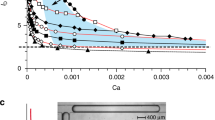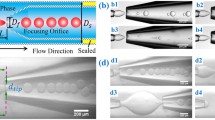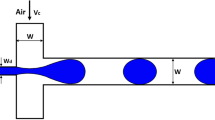Abstract
Step-emulsification is a microfluidic technique for droplet generation which relies on the abrupt decrease of confinement of a liquid filament surrounded by a continuous phase. A striking feature of this geometry is the transition between two distinct droplet breakup regimes, the “step-regime” and “jet-regime,” at a critical capillary number. In the step-regime, small and monodisperse droplets break off from the filament directly at a topographic step, while in the jet-regime a jet protrudes into the larger channel region and large plug-like droplets are produced. We characterize the breakup behavior as a function of the filament geometry and the capillary number and present experimental results on the shape and evolution of the filament for a wide range of capillary numbers in the jet-regime. We compare the experimental results with numerical simulations. Assumptions based on the smallness of the depth of the microfluidic channel allow us to reduce the governing equations to the Hele-Shaw problem with surface tension. The full nonlinear equations are then solved numerically using a volume-of-fluid-based algorithm. The computational framework also captures the transition between both regimes, offering a deeper understanding of the underlying breakup mechanism .






Similar content being viewed by others
References
Afkhami S, Renardy Y (2013) A volume-of-fluid formulation for the study of co-flowing fluids governed by the Hele-Shaw equations. Phys Fluids 25:082001
Anna S, Bontoux N, Stone H (2003) Formation of dispersions using “flow focusing” in microchannels. Appl Phys Lett 82:364–366
Dangla R, Fradet E, Lopez Y, Baroud CN (2013) The physical mechanisms of step emulsification. J Phys D 46:114003
Garstecki P, Fuerstman MJ, Stone HA, Whitesides GM (2006) Formation of droplets and bubbles in a microfluidic T-junction-scaling and mechanism of break-up. Lab Chip 6:437–446
Guillot P, Colin A, Utada AS, Ajdari A (2007) Stability of a jet in confined pressure-driven biphasic flows at low Reynolds numbers. Phys Rev Lett 99:104502
Guillot P, Colin A, Ajdari A (2008) Stability of a jet in confined pressure-driven biphasic flows at low Reynolds number in various geometries. Phys Rev E 78:016307
Humphry KJ, Ajdari A, Fernández-Nieves A, Stone HA, Weitz DA (2009) Suppression of instabilities in multiphase flow by geometric confinement. Phys Rev E 79:056310
Labrot V, Schindler M, Guillot P, Colin A, Joanicot M (2009) Extracting the hydrodynamic resistance of droplets from their behavior in microchannel networks. Biomicrofluidics 3:012804
Malloggi F, Pannacci N, Attia R, Monti F, Mary P, Willaime H, Tabeling P (2010) Monodisperse colloids synthesized with nanofluidic technology. Langmuir 26:2369–2373
Priest C, Herminghaus S, Seemann R (2006) Generation of monodisperse gel emulsions in a microfluidic device. Appl Phys Lett 88:024106
Rayleigh L (1878) On the instability of jets. Proc Lond Math Soc 10:4–13
Seemann R, Brinkmann M, Pfohl T, Herminghaus S (2012) Droplet based microfluidics. Rep Prog Phys 75:016601
Shui L, van den Berg A, Eijkel JCT (2011) Scalable attoliter monodisperse droplet formation using multiphase nano-microfluidics. Microfluid Nanofluid 11:87–92
Thorsen T, Roberts RW, Arnold FH, Quake SR (2001) Dynamic pattern formation in a vesicle-generating microfluidic device. Phys Rev Lett 86:4163–4166
Wörner M (2012) Numerical modeling of multiphase flows in microfluidics and micro process engineering: a review of methods and applications. Microfluid Nanofluid 12:841–886
Acknowledgments
Authors gratefully acknowledge Dr. Jean-Baptiste Fleury (Saarland University) for helpful discussions and the DFG-GRK1276 for financial support. This work was partially supported by the NSF Grant Nos. DMS-1320037 (S.A.) and CBET-1235710 (L.K.).
Author information
Authors and Affiliations
Corresponding author
Electronic supplementary material
Below is the link to the electronic supplementary material.
Supplementary material 1 (avi 1124 KB)
Rights and permissions
About this article
Cite this article
Hein, M., Afkhami, S., Seemann, R. et al. Capillary focusing close to a topographic step: shape and instability of confined liquid filaments. Microfluid Nanofluid 18, 911–917 (2015). https://doi.org/10.1007/s10404-014-1481-0
Received:
Accepted:
Published:
Issue Date:
DOI: https://doi.org/10.1007/s10404-014-1481-0




